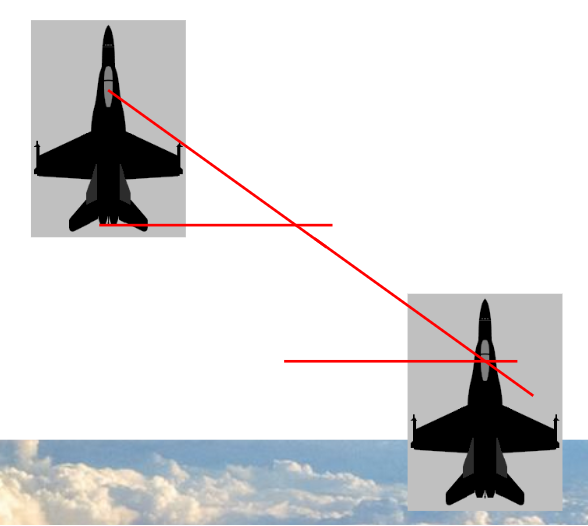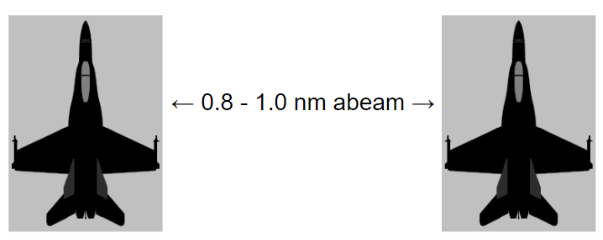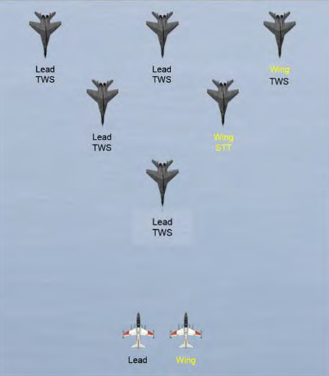¶ Overview
This document is intended to capture best practices, and to serve as a reference for how operations should normally progress & what members should expect.
¶ Roles and Responsibilities
¶ Mission Commander
The mission commander’s role is to coordinate the actions of all the flights in a particular operation or wave. This may include signaling all the flights to start ingressing into the vulnerable zone (hostile territory). The mission commander will typically be either a flight lead or AIC.
¶ Flight Lead - Pilot
The lead pilot is responsible for ensuring that their flight understands the mission, the ROE, and the flight plan. The flight lead assumes primary responsibility for navigation and secondary responsibility for visual lookout. The lead pilot is responsible for execution of the flight plan and directing the usage of formations. Finally, flight leads should maintain awareness of the fuel and weapons state of their flight members.
Lead Pilots should be comfortably familiar with all aspects of F-15E operation related to their role and the mission.
¶ Flight Lead - WSO
The lead WSO is responsible for ensuring that their flight understands the mission, the ROE, and the targeting procedures. The lead WSO assumes primary responsibility for radar lookout and directing the radar mating plan. They also assume primary responsibility for commit and targeting decisions. Post-commit, the LWSO should assertively dictate the flow of the engagement to their flight members.
Lead WSOs should be comfortably familiar with all aspects of F-15E operation related to their role and the mission.
¶ Wingman - Pilot
The wing pilot is responsible for supporting the flight lead in completing the mission. This support mainly comes from proximity and distribution of roles; therefore the wingman is less concerned with navigation and more concerned with visual lookout. The wing pilot stays close to the flight lead, maintaining the assigned formation. While the lead pilot and WSO usually talk, the wing pilot mostly just listens.
¶ Wingman - WSO
The wing WSO is responsible for supporting the flight lead in completing the mission. This support mainly comes from executing the mating plan directed by the lead WSO. During intercepts, the wing WSO is responsible for executing the briefed sorting plan and employing on the correct target.
¶ Communications
¶ Background and Techniques
¶ Radios in the F-15E
The F-15E has three radios by default: an ARC-164 UHF radio (R1), and two ARC-210 VHF/UHF+FM radios (R2+3).
(Radio 3 is currently not available.)
By default, the common frequency will be tuned on Radio 1, with Radio 2 being reserved for interflight. In all circumstances it is the pilot's responsibility manage and speak on both radios, with the exception of the WSO being given charge of any interactions with a JTAC.
¶ Elements of a radio transmission
Radio communications fall into two categories of “Descriptive” and “Directive” messages.
Descriptive comms are intended to convey information from one station to another. Descriptive comms generally follow a standard format of “[Recipient’s callsign], [Sender’s callsign], [Message]”.
Recipients of descriptive comms should acknowledge receipt by saying their own callsign or flight number, i.e. “Ripper12” [pronounced “Ripper-one-two”] or just “Two” on tactical.
Directive comms are used to direct pilots to take specific actions. Directive comms generally follow a standard format of “[Recipient’s callsign], [Command]”.
Recipients of directive comms do not need to verbally acknowledge the command; they should safely and correctly execute the given directive.
¶ A note on Brevity
The CSG-8 website lists a variety of brevity codewords used within the community, the vast majority of which are standard to the US DoD and the flight sim community at large.
While proper usage of brevity codes can facilitate speedy and precise communication, it is more important to say what you need to say quickly and to get your information across. It is totally acceptable to use plain English to communicate on the radio when you don’t know applicable codewords. However, do NOT try to fumble your way through a transmission without thinking it through first, as this will likely only confuse listeners.
If you are unfamiliar with a brevity codeword that someone else uses, ask. Many brevity terms have meanings that are not obvious, could be easily misconstrued, or that are misunderstood by portions of the DCS community.
¶ Vocal Technique
How you talk on the radio can convey as much meaning and significance as what you say. Therefore it is important to use the correct tone and inflection when sending descriptive or directive communications.
Generally, think about what you intend to say before you key the mic. While this can be difficult under stress, it will go a long way towards keeping your delivery concise and allowing everyone a chance to use the channel. Remember that in SRS, not only can you not hear anyone else transmitting while you are transmitting yourself, but anytime two or more stations transmit on the same channel, it sounds an alarm tone that prevents anyone from hearing anything on the channel.
For descriptive comms, use a neutral tone of voice. Try to speak clearly, like you’re giving a presentation. While some messages can take a long time to send, do not stay keyed up for more than a single sentence at a time. Take brief pauses to allow higher-priority traffic a chance to filter in.
For directive comms, use an authoritative, assertive tone of voice. Use inflection to help grab the attention of the intended recipient. Use simple, active verbs whenever possible.
¶ Keep the Channel Available
The number of speakers on the radio need to be minimized, and the order of speakers needs to be standardized, for the following reasons:
-
There is a limited amount of time available to send and listen to each transmission.
-
A large number of transmissions increases the odds that two transmitters will block each other.
-
In high-stress situations, transmissions are missed due to task saturation or auditory exclusion.
-
People tend to tune out conversation that is repetitive, or unrelated to them, and it can be difficult to quickly regain their attention.
-
Time spent listening or talking on the radio is time not spent doing other tasks.
¶ Standard Procedures
¶ Assigned Speakers and Flow
Aircraft should designate ONE aircrew to be the main speaker on the radio.
In a 2-ship flight, wingmen should only report contacts not reported by other players.
In a 4-ship flight, wingmen (-2 and -4) should speak only by exception, i.e. to report an untargeted group inside weapons range.
Allow long enough pauses between transmissions for everyone to process the information, before starting your own transmission.
- Listen to conversations even if they don’t involve you, as they will build your SA.
- This does not apply to critical directive comms i.e. “2, break right!”.
¶ Administrative Communications
Flight Leads should be the first to check in to a new frequency. Wait 10-15 seconds after switching channels to ensure that you are not interrupting a conversation.
If checking in to an AIC frequency with all briefed aircraft, check in should be “as fragged”. If down aircraft, i.e. due to technical issues, check in should give the number of aircraft in the flight.
¶ Intercept Communications
Flight leads should establish a cadence for their transmissions post-commit, which is utilized by other players on the channel to deconflict transmissions.
- A common cadence is every 10-15 seconds, which for an air intercept should be cued by each 5NM of closure.
- Element leads (-3) should give their update after flight lead.
- AIC and wingmen should speak by exception to report untargeted groups, or at request. AIC should give updates when fighters do not have sensors facing the target.
- Some flight leads may prefer for AIC to give more frequent updates. It is recommended to set expectations in the mass brief.
Players should follow the flight lead’s cue for format (BRAA vs. Bullseye vs. AREO)
Players should not repeat info that has already been transmitted.
- DO: If your flight lead or AIC report a group at, for example, BRAA 180/20/20,000/Hot - and you get radar contact on it, reply with “[...] contact same.”
- DON’T: Repeat the BRAA vector to the contact.
Players should focus their communications on building situational awareness both for themselves and others, from pre-commit up to the targeting phase of an engagement.
- DO: Determine as quickly as possible:
- How many bandit groups exist?
- What is the shape of the PICTURE?
- What are the closest groups on the PICTURE?
- What are the bandits doing? Are they aware or unaware of us?
- DO: Be prepared to adjust the sort plan based on whether wingmen see the whole picture.
- DON’T: Transmit unessential information when any friendly flights on the channel have committed.
Flight leads should transition from SA-building comms to targeting/sorting comms approximately 30 seconds (10NM) prior to reaching shot range.
- DO: Have a pre-briefed shot range for high and low altitude.
- DO: Have a pre-briefed sort plan that can be applied to various pictures.
- DO: If there is a need to deviate from the sort plan, flight lead should use either BRAA or AREO format to assign targets. All players on the channel need to be consistent with the format chosen by flight lead.
The flight member with the closest target should be the first to call their FOX.
¶ Briefing
Each op typically begins with a 10-15 minute mass briefing, during which the situation, mission, and plan of execution are summarized by the mission maker. The mass briefing concludes with questions from flight leads only.
After mass briefing, there will be a 10-15 minute period for flight leads to brief their flight members in further detail on the flight plan, and to reiterate important standard procedures.
At the end of the flight briefing, the server will be unpaused and flights will start spawning on the field according to the briefed schedule. Pilots should spawn their jets solo, without a WSO in order to avoid certain DCS bugs.
¶ Pre-Takeoff
¶ Fuel/Weapon Loads
Fuel and weapon loads are typically pre-set by the mission maker. In the event that the loads are not pre-set or need to be changed, flight leads will have the authority to direct the fuel and weapon load to be selected on the deck.
Due to various bugs related to the INS, it is recommended that your ramp position be entered manually before INS alignment, and that neither crew member perform any actions during alignment. It is also recommended that the radar be OFF.
¶ Post Launch
¶ Formations
¶ Cruise

Cruise formation is preferred when FENCED out. In cruise formation, the flight members remain on the 40-degree bearing line within .5NM. The advantage of this formation is that it is easy for wingmen to maintain.
¶ Combat

¶ 2-Ship
A single-section flight should stick to a standard combat spread (.8 to 1.0 NM abeam, wingman stepped up 1000 feet) when fenced in for day VFR missions. A wider formation without visual support, or even individual flight plans, may be briefed for night or IFR missions.
¶ 3-Ship
A 3-ship flight should operate together, similar to how a 4-ship division would fly in a visually supporting formation. If feasible (i.e. day VFR), the -2 wingman should fly in a close welded-wing formation to the flight lead, while -3 keeps a standard or widened combat spread.
¶ 4-Ship
A 4-ship flight should operate either together as a division, or as two independent sections, depending on the mission.
¶ FENCE Checklist
¶ FUEL/FIREPOWER
MASTER ARM: SET
A/G DELIVERY: PROGRAM SET
MASTER MODE: SET
BINGO: SET
FUEL: REPORTED
¶ EMITTERS
T- TACAN
R- RADIOS, RADAR
A- ALR/ALQ
I- IFF
L- LIGHTS : OFF
¶ NAVIGATION
NAVIGATION POINT: AS NEEDED
AUTO SEQ: AS NEEDED
¶ CHAFF/FLARE
DISPENSER: MAN/SEMI AUTO
¶ ECM
ICS: ON/AS NEEDED
¶ RADAR Mating Plan
¶ 2-ship
Flight Lead: RWS ILV | 60 DEG | 6 BAR | AZIMUTH LEFT |
Wingman: RWS ILV | 60 DEG | 6 BAR | AZIMUTH RIGHT |
¶ 3-ship
Flight Lead: RWS ILV | 60 DEG | 6 BAR | AZIMUTH LEFT | LEVEL |
Wingman: RWS ILV | 60 DEG | 6 BAR | AZIMUTH LEFT | LEVEL |
Element Lead (-3): RWS ILV | 60 DEG | 6 BAR | AZIMUTH CENTER | LEVEL |
¶ 4-ship (operating together)
Flight Lead: RWS ILV | 30 DEG | 6 BAR | AZIMUTH LEFT | LOW |
Wingman (-2):RWS ILV | 30 DEG | 6 BAR | AZIMUTH RIGHT | HIGH |
Element Lead (-3): RWS ILV | 30 DEG | 6 BAR | AZIMUTH LEFT | HIGH |
Wingman (-4): RWS ILV | 30 DEG | 6 BAR | AZIMUTH RIGHT | HIGH |
¶ Sorting

The flight should sort from left to right, if possible. Flight lead takes the left track or group, regardless of whether his wingmen are on his left or right side. -4 will take the contact furthest to the right.
If an azimuth sort is not possible, the flight should sort by range, where the flight lead takes the leading track or group.
If a range sort is not possible, the flight should sort by elevation, where the flight lead takes the low track or group.
If the flight’s formation is not well established, or if there are other complicating circumstances, the flight lead may direct deviations from the standard sorting doctrine.
¶ Intercept Timeline
¶ Pre-Commit
Pre-Commit describes when a fighter flight is fenced in and either at their assigned station, or on their flight plan in an area where air combat might take place.
-
DO: Maintain a lookout for threats (Pilots mantain SA using SIT and A/A radar, WSOs to use SIT and outisde visibility).
-
DO: Listen to the radio, and make SA-building communications as needed.
-
DON’T: Have unnecessary or off-topic conversations, even within an aircraft on ICS.
¶ Commit
COMMIT is a directive/descriptive brevity term that describes that a fighter flight is leaving their CAP orbit or deviating from their flight plan to intercept one or more bogey groups.
-
DO: Maintain the briefed formation and assigned RADAR scan.
-
DO: Listen to the flight lead and AIC for targeting and range/closure information, and be prepared to MELD your RADAR scan zone onto your target group at about 10NM prior to shot range.
-
DO: Be ready to sort according to the sort doctrine, or flight lead directions.
-
DON’T: Repeat any information on the radio.
¶ Shot
First shots should be made no later than crossing the briefed shot range. It is critical to ensure that one weapon is assigned to each track without any tracks going un-targeted.
-
DO: Call shots (“FOX 3”) in order of target range (this should roughly correspond to the order in which weapons are actually fired).
-
DO: Maintain the formation after shooting. Flight or element lead will determine maneuvers to be made after shooting (i.e. Crank).
-
DON’T: Maneuver independently of the formation in response to a threat launch warning.
-
DON’T: Call out SPIKED or any threat missile launches if one of the flight members has already called SPIKED - it’s unnecessary and takes up air time.
¶ Going Out
If the flight’s directed flow is SKATE (launch-and-leave tactics) or if shots are TRASHED on a BANZAI flow (launch-and-decide tactics), the flight or element lead may direct an OUT maneuver to separate from the target group. It is critical to maintain the formation and listen to the flight lead for further instructions.
-
DO: Peek at the RWR and see if you are SPIKED or NAKED.
-
DO: Set up your RADAR for the best chance of picking up the target group quickly if you turn in. Flight lead should give some direction here.
-
DO: Check your fuel and weapons state and be ready to report them to your flight lead.
-
DO: Be ready to split the formation if your flight lead directs it.
¶ Going In
If the flight’s flow is BANZAI and shots are effective at forcing the bandits’ noses away, the flight or element lead may direct a PRESS or IN maneuver. It is critical to maintain a visually supporting formation, as well as a visual lookout, and to listen for further instructions.
-
DO: Call TALLY upon getting visual contact of a bogey/bandit, and give the direction (i.e. “TALLY two, 12 o’clock low”)
-
DO: Pilots assume RADAR control upon gaining TALLY within the HUD FOV, if not already in STT.
-
DO: WSOs support pilots in gaining TALLY via AREO reports, if able.
-
DON’T: Split the formation, unless:
- Flight lead directs it, or
- An untargeted group pops up nearby.
¶ Merge
TBD